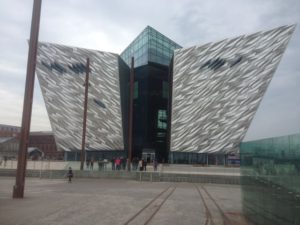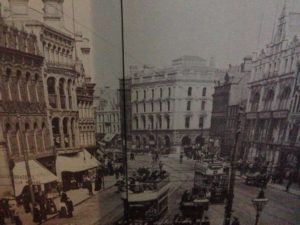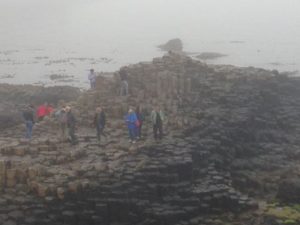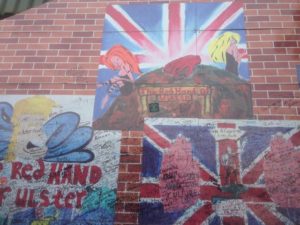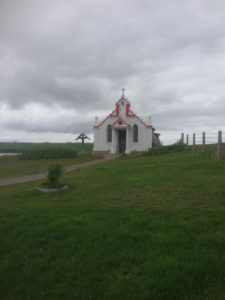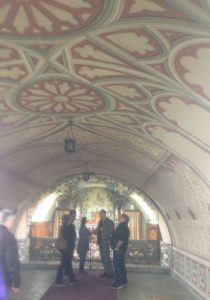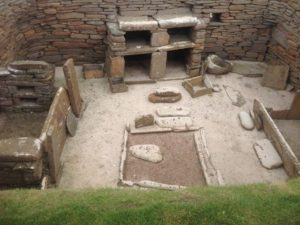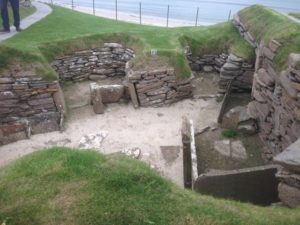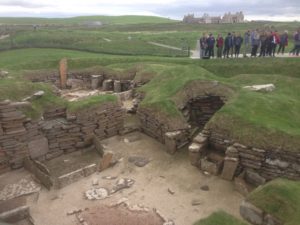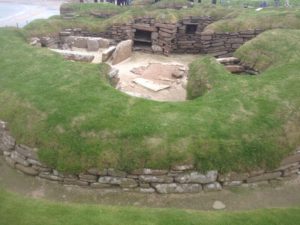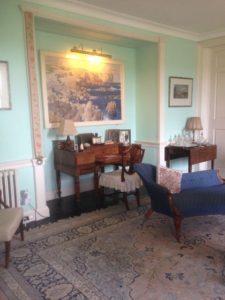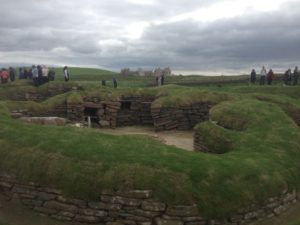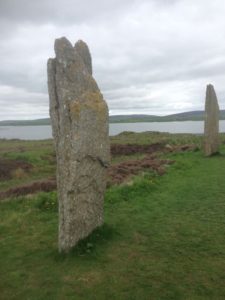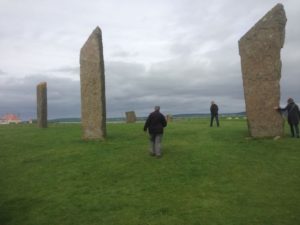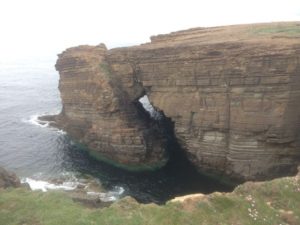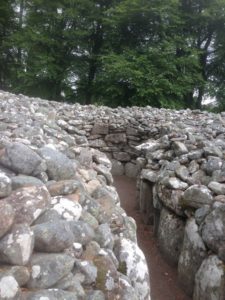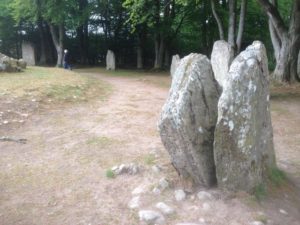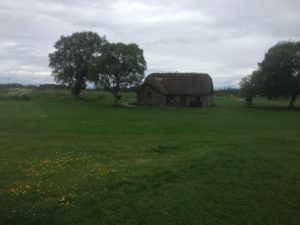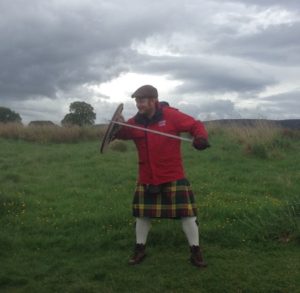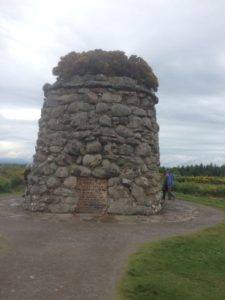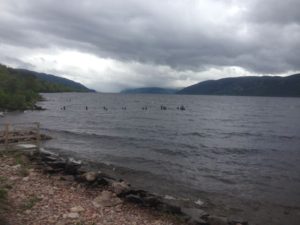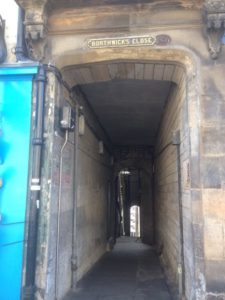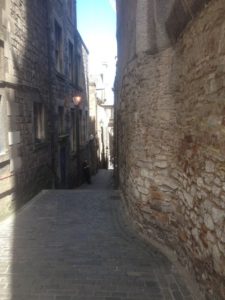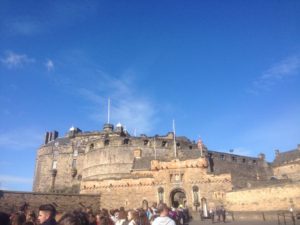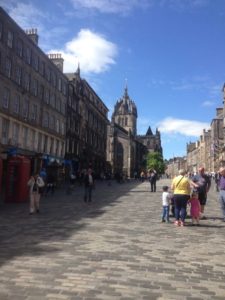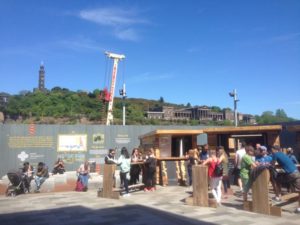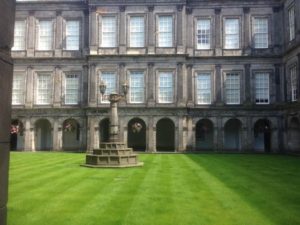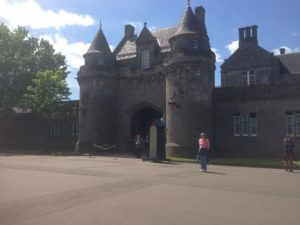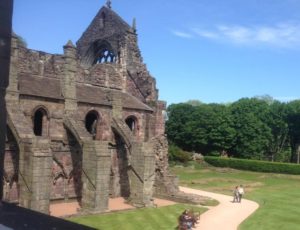A shuttle is required from the port to the town center, but we have booked a tour through McCombs and are met at the dock by the McCombs bus. Patrick, our driver, gave us a tour through the cathedral quarter, once run down but being rebuilt today.
The population of Belfast, including suburbs, is around 700 thousand, so it’s a relatively small city. Northern Ireland is 1.7 million and Ireland is 6 million (3 million less than before the famine). Northern Ireland is a separate country, part of the United Kingdom (England, Wales, Scotland, and Northern Ireland), and it uses the British pound as currency. The protestant population dates back to the English and Scottish settlers who were introduced under Queen Elizabeth I.
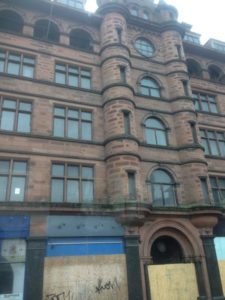 Belfast city has the feel of a city recovering from bad times. Many buildings are still boarded, but recovery is underway and many of the old buildings are being converted into hotels. Belfast doesn’t have enough rooms to accommodate the tourists who have only recently started visiting Northern Ireland after the history of violence that plagued it during “the Troubles.”
Belfast city has the feel of a city recovering from bad times. Many buildings are still boarded, but recovery is underway and many of the old buildings are being converted into hotels. Belfast doesn’t have enough rooms to accommodate the tourists who have only recently started visiting Northern Ireland after the history of violence that plagued it during “the Troubles.”
We saw St Anne’s Cathedral with the largest Celtic cross in the world, and the 1906 Belfast City Hall, built over what had been the center of the linen industry. (Belfast was the world’s largest producer of fine linen). The furniture in city hall, created by French and Italian craftsmen, was intended for the Titanic but was not completed in time for the maiden voyage and was installed in city hall when the ship never returned. We passed many of old Victorian buildings that are now being converted into hotels.
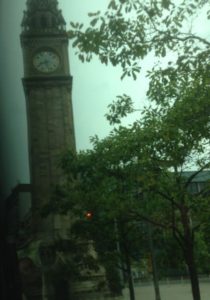 The Albert Memorial clock was built on soft ground over the river and quickly began sinking. Although saved, it permanently tilts four feet back and to the right and is said to have both the time and the inclination.
The Albert Memorial clock was built on soft ground over the river and quickly began sinking. Although saved, it permanently tilts four feet back and to the right and is said to have both the time and the inclination.
The city built a weir on the tidal river to maintain the artificial high tide and avoid the stench of low tide. The weir brought salmon back to the river.
The Titanic exhibit cost over 100 million pounds and is built on the site of the original ship building yard. It is quite a gorgeous building that stands as high as she ship when she was being built and covered with 2,500 tiles for the 2,500 passengers and crew that were supposed to be aboard during the maiden voyage (not all made it). 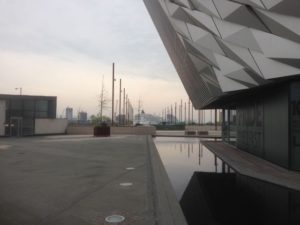
The posts mark the slipway of the Titanic (with the NCL Jade in the background).
We were there at 8:45 when the exhibit opened, so we were able to tour the building before the crowds arrived. We spent two hours in one of the best designed exhibits I have ever seen. The four-floor self-guided tour tells the story of the industrialization of Belfast’s linen and ship building industries through the use of old photographs and film footage. It then tells the story of how the ship was built. There is even a ride through the bowels of the ship as rivets are heated, tossed, caught and pounded into the steel plates of the hull. Ten thousand people were employed building the ship and 100,000 showed up to watch the launch of the greatest luxury liner ever built.
There are displays of the first, second and third class quarters and moving first-hand accounts of survivors experiences as the ship went down.
The Discovery theater shows images of the discovery of the Titanic on the ocean floor and of the debris field of bottles and shoes that still litters the ocean floor between the two sections of the hull.
As we drove out of town to our second destination, Carrick-a-Rede and the Giant’s Causeway, Patrick talked about the sectarian divisions in Northern Ireland. Northern Ireland is 45% Catholic and 47% Protestant (although the numbers were more heavily Protestant when Northern Ireland was partitioned from Ireland.
The differences between the two sides is not so much based on religious differences but on national identity. The Republicans (Catholic) identify with Ireland and favor one unified Ireland, and the Nationalists identify themselves as British and want to remain part of the United Kingdom.
What amounted to a civil war began in the 60’s with Catholic protests against discrimination. What began as marches, turned into riots, and British troops came in to restore order and remained in Northern Ireland for thirty years while paramilitary groups on both sides waged civil war. One hotel in Belfast, the Europa, where most of the journalists stayed, was bombed forty times.
Bill Clinton and George Mitchell were responsible for brokering a peace agreement in 1998, which was then approved by 70% of Northern Ireland and 90% of Ireland. Since then, peace has brought new prosperity and investment to Northern Ireland. They are worried about what the Brexit vote will mean. They voted, like Scotland, to remain in the European Union. The loss of European union money and having to install border controls are consequences that no one wants.
Patrick talked about how people know who is Catholic and who is Protestant (asking would be considered extremely rude). Names are the first giveaway. Catholics tend to be named for saints and Protestants tend to be named for the Royal Family. Where someone lives is another indication as there are segregated neighborhoods, and where someone went to school is the third indicator. Catholics tend to go to private Catholic schools and Protestants to Protestant public schools.
After a little over an hour ride through gorgeous countryside with green fields and lots of sheep, cattle, and blooming hawthorne hedgerows, we arrived at Carrick-a-Rede, a rope bridge that crosses from the mainland to a small island where fisherman traditionally netted salmon in the summer months, catching 200-300 salmon a day for the four month spawning season.
Unfortunately, they overfished the waters, and the salmon population dropped and there was no longer a fishery. We stopped for photographs but the hike down to the bridge is 25 minutes and we didn’t have time to do that.
The Giant’s Causeway, ten minutes down the road, is a geologic marvel of hexagonal basalt volcanic columns formed during a volcanic eruption 50 to 60 million years ago.  The lava cooled slowly and cracked and crystalized, forming 40 thousand hexagonal columns.
The lava cooled slowly and cracked and crystalized, forming 40 thousand hexagonal columns.
Unfortunately, fog descended just as we did and we were socked in with no visibility, which made the several walking paths less appealing than they would have been on a sunny day. We opted to have a pint of Guinness and a steak and Guinness pie in the Nook pub before taking a shuttle down to the causeway (1 pound each way). The hexagonal columns form perfect stepping stones and are so regular that they seem man-made.
On our return to Belfast, Patrick drove us through the sectarian area of the city separated by a forty foot wall, called the peace wall, that has gates that are closed at 7pm and not reopened until 7 am.
 On the Nationalist side, houses fly the Union Jack and stores have murals celebrating Protestant martyrs. The divisions are palpable, with the Unionists wearing red (the Red Hand of Ulster is a symbol). Schools are still segregated, so kids learn division and hatred from their parents and peers.
On the Nationalist side, houses fly the Union Jack and stores have murals celebrating Protestant martyrs. The divisions are palpable, with the Unionists wearing red (the Red Hand of Ulster is a symbol). Schools are still segregated, so kids learn division and hatred from their parents and peers.
We stopped at the wall and had a chance to write a peace message, but the chances of the wall coming down anytime soon are nill. A recent poll showed 100% of people living on both sides of the wall wanted it to remain.
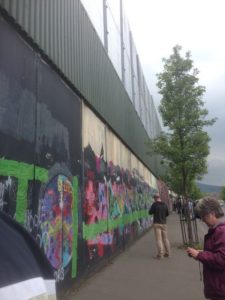 The Republican Falls Road side had murals and graffiti celebrating rebels all over the world and murals honoring Bobby Sands, the IRA prisoner who died in a hunger strike along with ten others. We saw lots of green shirts and Irish flags.
The Republican Falls Road side had murals and graffiti celebrating rebels all over the world and murals honoring Bobby Sands, the IRA prisoner who died in a hunger strike along with ten others. We saw lots of green shirts and Irish flags.
A Republican would never dream of walking into a Unionist pub and vice-versa.
It is truly a sad situation, with working class people who have more in common than they have differences pitted against one another by their identification with their group/side. I thought of Jonathan Swift and his big-endians and little-endians, and unfortunately of the political divisions rending our country.





